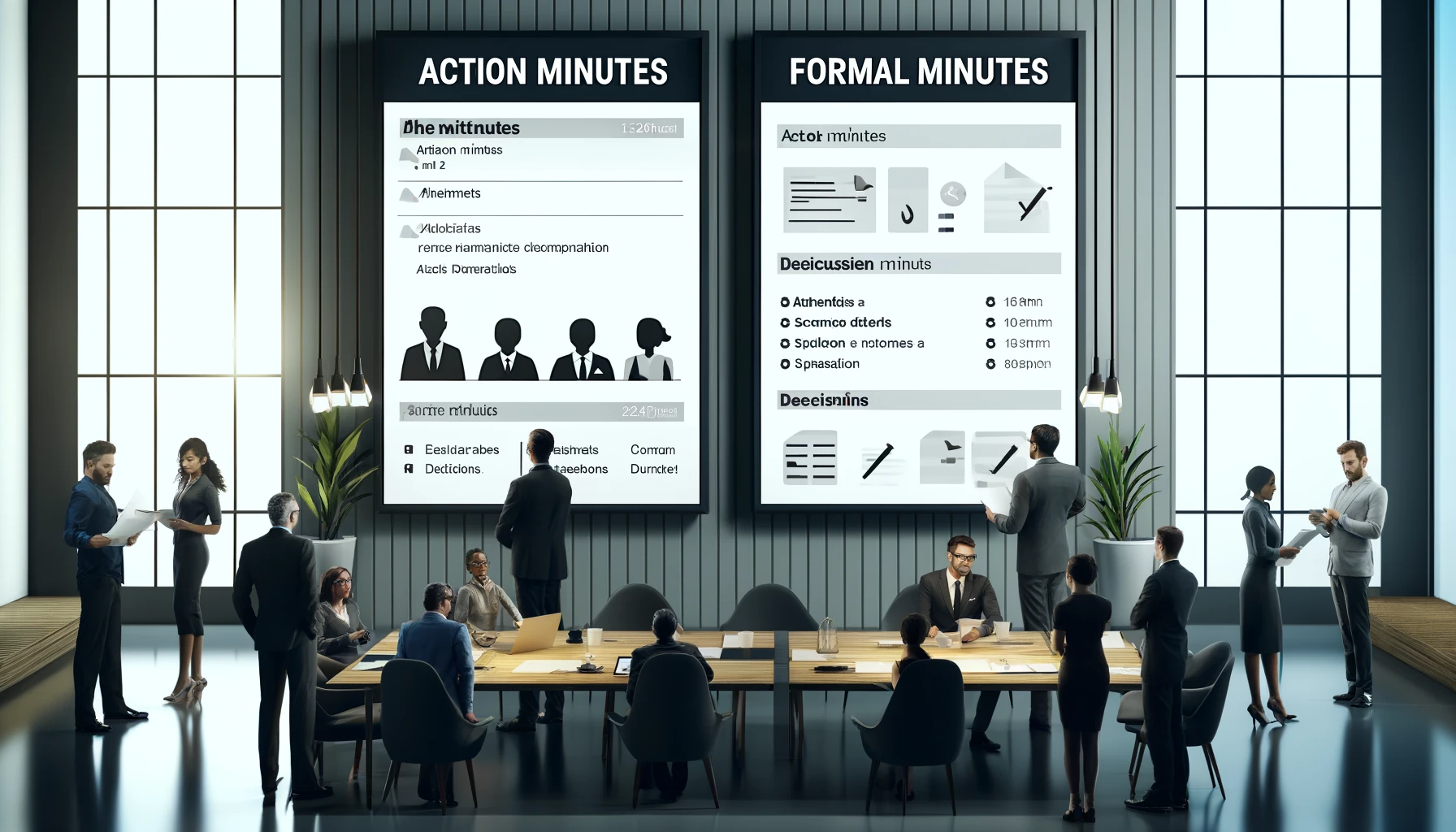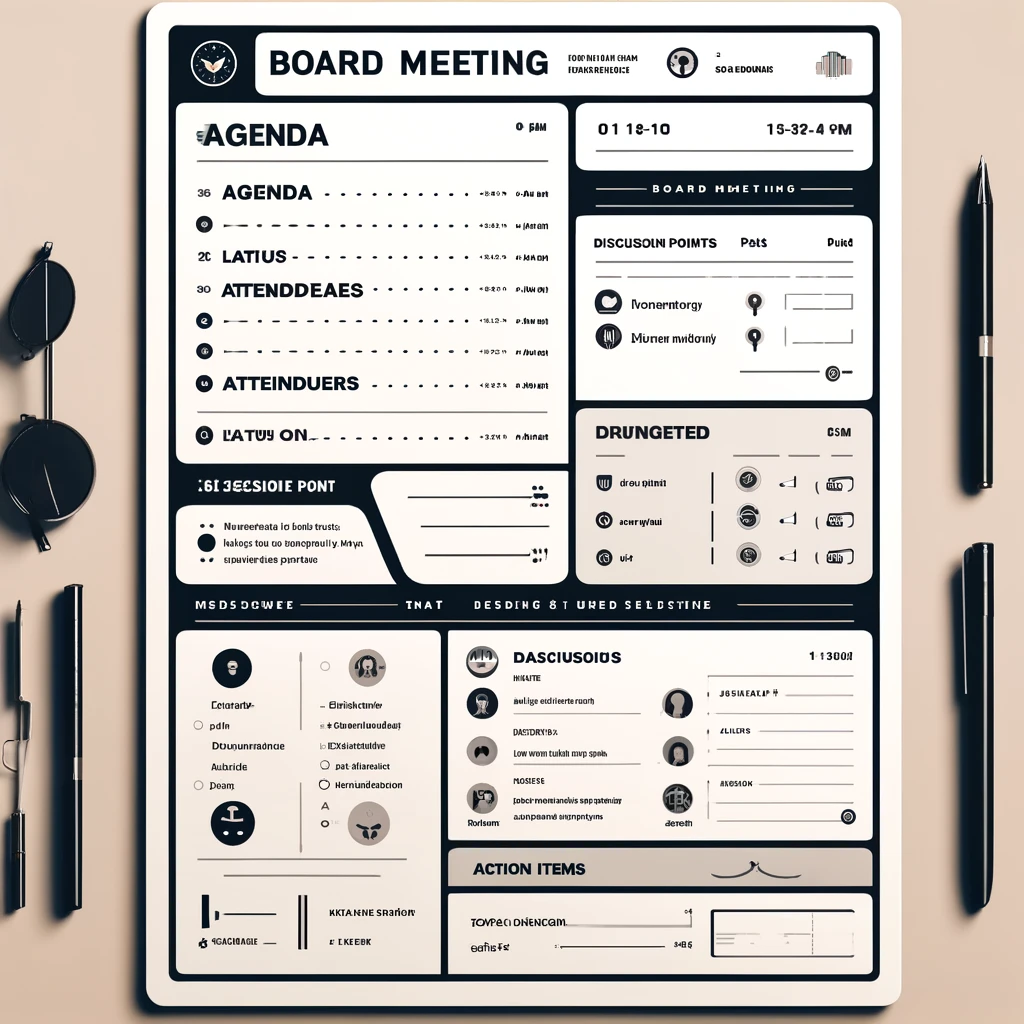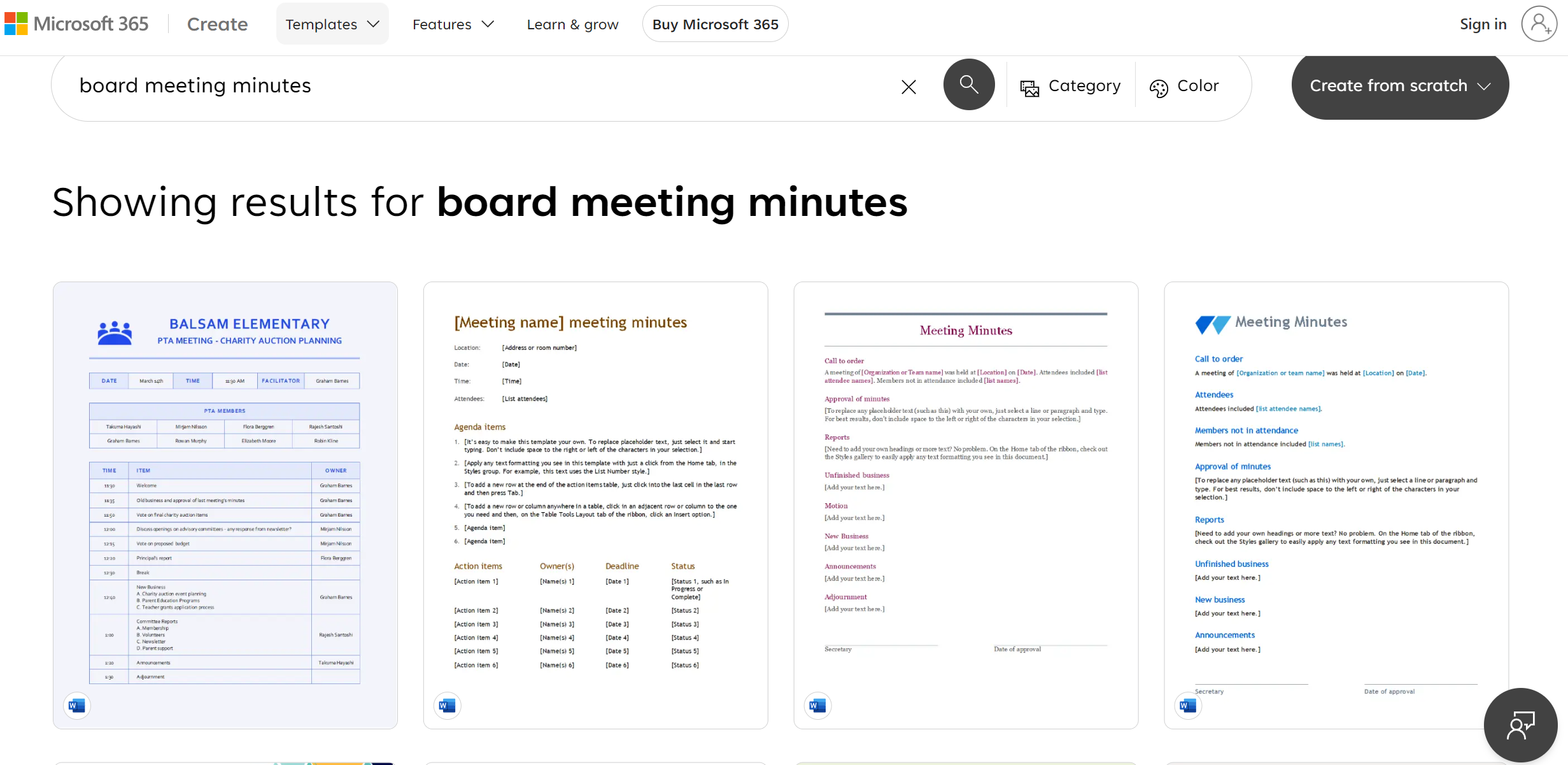- Board meeting minutes objectively record what takes place during a board meeting.
- Properly taken board meetings encourage transparent communication and resolve critical issues at organizations.
- An AI-powered meeting assistant knows how to take minutes at a board meeting like a pro.
Ready to elevate your organization’s strategic clarity and accountability? Look no further: take board meeting minutes. They’re more than a formal record: these minutes help capture vital insights and decisions that shape your company’s future.
If you want to learn to write board minutes correctly and transform simple note-taking into an art form, you’re at the right place. Let’s explore the importance of these minutes and go through board meeting minutes examples, best practices, and templates.
Moreover, let’s reveal how an AI meeting assistant can help you enhance your organization’s decision-making through productive note-taking.
What Are Board Meeting Minutes?

Board meeting minutes reflect the objective record of critical discussions, decisions, and actions taken during board meetings. Specifically, a “board of directors” represents individuals elected or appointed to supervise an organization’s strategic direction, policymaking, and governance.
The board secretary or a dedicated minute-taker is often responsible for taking board meeting minutes using a Board of Directors meeting minutes template. The aim is to gather the necessary information in one location and do it effectively.
I remember how challenging it was to organize meetings remotely during the last few years. Who hasn’t had their meetings interrupted by someone’s child crying in the background or the internet connection drop right before a critical online discussion?
Thankfully, an AI minute-taking assistant can help take meeting minutes effectively and without distractions. How? You should use an AI meeting assistant that removes background noise distractions and effortlessly automates meeting transcriptions.
What about the frequency of taking board meeting minutes? Taking them at every official board meeting is critical to ensure a consistent and accurate record of all discussions, decisions, and actions. And most organizations hold board meetings quarterly.
Once approved by the Board, these minutes become the official record of the topics discussed, decisions reached, and further actions to take. Notably, the company should distribute the minutes to absent members so they can stay abreast of the Board’s discussions and actions.
Be aware that nonprofit boards, committees, and other established groups use Robert’s Rules of Order to know how to govern discussions and decision-making. And the US Internal Revenue Service requires corporations to keep minutes of the Board of directors’ meetings.
Why Do You Need to Take Board Meeting Minutes?

You should take minutes at board meetings because they’re a legal document that captures the Board’s due diligence, decisions, and considerations.
Consider the case of a company that faced a lawsuit alleging that directors didn’t act in the company’s best interest. Unfortunately, the company couldn’t prove compliance with legal standards and defend the Board’s decisions.
Why? Because the company needed to keep accurate board meeting minutes to provide evidence of the Board’s discussions and rationale behind its decisions. As a result, the company ended up with fines, penalties, or severe legal repercussions.
Here are the key benefits of jotting down board meeting minutes:
- Legal and Regulatory Compliance: The recorded materials let you showcase your lawful operation. If your state has specific rules governing these minutes, ensure you comply.
- Evidence of Due Diligence: The minutes help you demonstrate in legal disputes, lawsuits, or audits that the Board considered relevant information and made informed decisions.
- Historical Reference: These recordings reference the organization’s past decisions, strategies, and policies for future board members, executives, and stakeholders.
- Transparency, Trust, and Accountability: Meeting members can review the accurately recorded proceedings and use them to act as needed. Thus, everybody stays on the same page, and responsibilities are accomplished without delay.
- Enhanced Communication: Board members can easily share the recorded materials among present and absent meeting members to facilitate communication.
- Conflict Resolution: Board meeting minutes are objective information sources that can help clarify misunderstandings and prevent conflicts.
- Strategic Planning: Board meeting members review the organization’s past strategic decisions to assess their effectiveness and make better future planning decisions.
- Increased Confidence: Accurately recorded meeting information inspires board members to conduct company governance and make decisions with greater confidence.
Types of Board Meeting Minutes

Minutes taken at board meetings vary in style and detail depending on the organization’s requirements, legal obligations, and the Board’s preferences. Here are the primary types:
1. Action Minutes: These concise minutes mainly display the decisions made and the responsibilities assigned without detailed discussions.
2. Discussion Minutes: These detailed minutes include discussion summaries, key points, and rationale behind decisions.
3. Verbatim Minutes: These are the most detailed board meeting minutes and are mainly reserved for legally sensitive meetings. They capture every word said during the meeting, resembling a meeting transcript.
4. Informal Minutes: This type is ideal for less formal settings or smaller organizations. It highlights the main points and decisions without a strict structure and format.
5. Formal Minutes: Finally, what are the formal minutes of board meetings? Formal board minutes adhere to a predefined format that organizations require due to their bylaws or legal standards. Additionally, these are thorough minutes that include attendees, motions, votes, and resolutions. The Board’s chairperson or secretary reviews, approves, and signs them.
Board Meeting Minutes Format

Are you wondering, “What are the contents of the minutes of a board meeting?” so you won’t end up with meeting madness? After all, every minute lost in a wasteful meeting hurts working creativity and efficiency.
A typical one includes:
- Agenda: List the points in the order in which they were discussed.
- Date and Time: Note the start and end.
- Location: Ensure compliance with legal and organizational requirements.
- Meeting Type: Is this a regularly scheduled, annual, or specific meeting?
- Formal Notice: This is the formal notice of the meeting to the directors.
- Attendees and Absences with the Reasons Why They Were Absent: Ensure accountability, legal compliance, and accurate follow-up.
- Guests: Add names, affiliations, and roles to clarify their contributions.
- Quorum: Was there a quorum present?
- Departures and Entries: When do people leave and rejoin the meeting?
- Reports: Jot down the vital points from the provided reports.
- Decisions: Ensure accountability, a legal record, and future steps.
- Resolutions: Include the resolutions agreed upon and dissenting votes.
- Action Items: Add action items with the responsible individuals, deadlines, and other supporting details, such as the scheduling of catch-up meetings if applicable.
- Adjournment: Note the time the meeting ended with the details of the next meeting (if applicable).
What Not to Include in Board Meeting Minutes?
You’ll prepare a reliable and concise reference for future decision-making by avoiding unnecessary details in your meeting minutes. So, what not to include?
- Abbreviations, acronyms, and jargon
- Judgmental comments
- Personal observations about meeting members
- Notes about personal arguments
- Personal interpretations and biases regarding others’ opinions
- Politics-related statements
- Exact discussions with lawyers giving legal advice
- Words of praise
- Side discussions away from the main agenda
How to Write Board Meeting Minutes Effectively with Krisp
Meeting minutes cover a lot of information, so they can become lengthy documents requiring days to compile. And you think fast typing is enough to capture the essence of meeting minutes, right? In fact, it’s not.
The way out is to use the advanced Krisp AI meeting assistant to confidently and precisely take board meeting minutes. Krisp ensures your minutes are accurate and can be a powerful tool for strategic management. Specifically, feature-rich Krisp uses advanced speech-to-text technology to transcribe audio-to-text with unmatched accuracy and effectiveness.
After all, as McKinsey alum Tom Peters says, endless, diffuse meetings take up too much of executives’ precious working time. And effective meetings and successful time management make up a virtuous circle.
So, how to take minutes at a board meeting using Krisp to create a comprehensive and accurate record of the proceedings?
- Download the Krisp App for Windows, Mac, Linux, iOS, or Android.
- Integrate it with any virtual conferencing service or platform—enabling AI note-taking in Zoom, Google Meet, and Microsoft Teams—no plugins required.
- Krisp will automatically record your meeting using its advanced Voice AI technology to deliver best-in-class audio clarity that is free from background noise, voice, and echo.
- Krisp will automatically provide multilingual meeting transcriptions with exceptional 96% accuracy to boost productivity and effectiveness.
- Krisp will summarize the vital discussions effectively.
- After the meeting, you can review and revisit your AI-generated meeting notes to make the necessary edits and work on action items.
- Finally, share your meeting notes with other meeting participants without challenges.
Template for Board Meeting Minutes

Here is an example of a board meeting minutes template with all essential elements. You can adjust the templates by including specific sections or details relevant to your company.
Company or organization’s name:
Meeting name:
Date of meeting:
Time of meeting:
Location of meeting:
Chairperson:
Secretary:
ATTENDANCE
- Attendees:
- Absent members:
- Guests:
- There [was or was not] a quorum present.
NOTICE
Notice [was or was not] provided. A waiver of notice [is or is not] included.
ORDERS OF BUSINESS
Unfinished business
- Names of those reporting:
- Names of those dissenting:
- Voting results:
- Critical points from reporting, dissenting, and voting:
New business
- Reports from the CEO or executive director:
- Reports from the finance department:
- Reports from committees:
- Other reports as needed:
- Key points and dissensions:
Action steps
- Key players:
- Specific tasks:
- Time frames:
CLOSING
- We will hold the next board meeting on [date and time].
- The meeting ended at [time].
- Signatures of minute taker and board president.
Template in Word Format

Are you interested in using a board meeting minutes template in Word? This template is a pre-formatted document that helps the minute-taker capture the relevant information. You can tailor it to your specific organizational needs.
- Meeting Title: Regular, special, or annual
- Date and Time
- Location
- Attendees: List of all board members present and absent. Sometimes, it includes guests or speakers.
- Call to Order: Notation of who called the meeting to order and when.
- Approval of Previous Minutes: Statement about accepting previous meeting minutes and corrections made.
- Agenda Items
- Discussion Points: Discussion summaries for agenda items.
- Decisions Made: Specific decisions voted on and their results.
- Actions Taken or Agreed Upon: Tasks assigned and responsibilities delegated, including deadlines and the responsible persons.
- New Business: New topics not included in the original agenda.
- Adjournment: The person who called for adjournment and the time the meeting ended.
- Next Meeting: Date and time for the next scheduled meeting (if known).
- Signatures: The signatures of the Chairperson and the Secretary.
Best Practices for Taking Board Meeting Minutes

How to take minutes for a board meeting using best practices? Below, you can find tried-and-tested tips to improve your minute-taking skills:
- Use a meeting minute app to avoid making minute-taking daunting.
- Prepare in advance by familiarizing yourself with the meeting agenda, attendees, and documents to be discussed.
- Revisit past meetings and honestly assess which ones were genuinely useful to schedule and allocate time properly.
- Review the rules governing board meeting minutes in your state to ensure you comply.
- Curate a compelling meeting agenda.
- Share the agenda ahead of the meeting.
- Record the motions, actions, and decisions to resolve any discrepancies.
- Utilize a structured board meeting minutes template.
- Have an attendee list.
- Take a roll call as soon as members arrive.
- Document a quorum.
- Don’t forget about the introductions.
- Inform participants that you’re recording the meeting.
- Include the essential details, such as the attendees, absentees, meeting date, and location.
- Ask for clarification when dealing with ambiguity.
- Focus on the essential meeting takeaways and varying perspectives.
- Use clear and brief sentences without overwhelming details.
- Describe board actions clearly.
- Note the responsible parties and deadlines clearly.
- Keep to the same verb tense.
- Highlight the key points in a clear summary using an AI meeting note taker: it’ll help you reorganize meeting discussions to fit your flow.
- Be objective and take notes neutrally without personal commentary or bias.
- Exclude information that could harm the Board in legal disputes.
- File and manage documents.
- Review and polish the draft post-meeting to ensure it’s coherent and flows logically before sharing it for approval.
- Ensures meeting minutes are approved without delay.
- Documents signed to keep them as official and legal records.
- Distribute minutes after the meeting without delay.
Wrapping Up
Board meeting minutes record what occurs during a board meeting, capturing the decisions, motions, critical deliberations, and details. Typically, the corporate Secretary writes the minutes, and the legal team reviews them so business leaders can approve them.
You can rely on the best practices and a reliable AI meeting assistant to take note-taking to the next level successfully. How? You can record meetings without distractions, transcribe, and summarize your discussions into a productive historical record of the meeting’s activities and outcomes.
Moreover, you can use a sample board meeting minutes to know what to include and exclude in your final product.
Frequently Asked Questions







